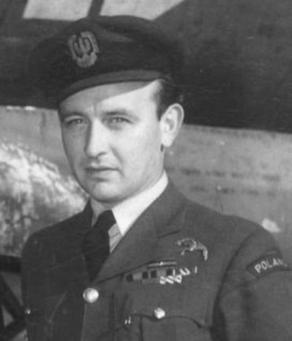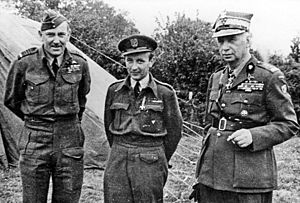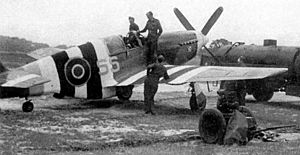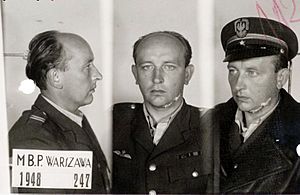Stanisław Skalski facts for kids
Quick facts for kids
Stanisław Skalski
|
|
|---|---|
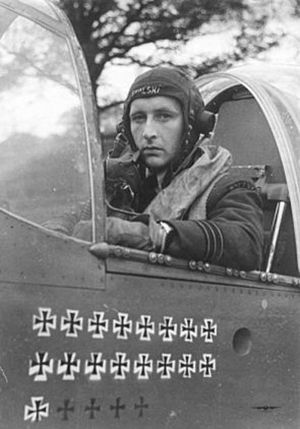 |
|
| Born | 27 November 1915 Kodyma, Russian Empire |
| Died | 12 November 2004 (aged 88) Warsaw, Poland |
| Allegiance | Poland United Kingdom |
| Service/ |
Polish Air Force Royal Air Force |
| Years of service | 1938–1945 1956–1972 |
| Rank | Generał brygady |
| Service number | 76710 |
| Commands held | No. 133 Polish Fighter Wing No. 131 Polish Fighter Wing No. 601 (County of London) Squadron Polish Fighting Team No. 317 (Polish) Squadron RAF |
| Battles/wars | Polish Defensive War Second World War |
| Awards | Golden Cross of the Virtuti Militari Knight's Cross of the Order of Polonia Restituta Cross of Valour (4) Order of the Cross of Grunwald Distinguished Service Order (United Kingdom) Distinguished Flying Cross & Two Bars (United Kingdom) |
Stanisław Skalski (born November 27, 1915 – died November 12, 2004) was a brave Polish pilot and a top fighter ace. He flew for both the Polish Air Force and the British Royal Air Force during World War II. Skalski was the best Polish fighter pilot of the war. He was also the very first Allied fighter ace, meaning he was the first pilot from the Allied side to shoot down five enemy planes. He was officially credited with nearly 19 victories, and some sources say it was even more.
After the war, he went back to Poland. However, he was wrongly arrested by the communist government. They accused him of being a spy for Great Britain. He was sentenced to death, but this was changed to life in prison. He stayed in prison until 1956 when a court finally said he was innocent. He then rejoined the Polish military. In 1988, he was promoted to the rank of brigadier general.
Contents
Early Life and Becoming an Ace
Stanisław Skalski was born in Kodyma, which is now part of Ukraine, on November 27, 1915. He finished pilot training in 1938. Soon after, he joined the 142nd Fighter Squadron in Poland.
Fighting in Poland (1939)
When World War II began on September 1, 1939, Skalski was immediately in action.
- He attacked a German reconnaissance plane, which was shot down by another pilot. Skalski even landed to help the wounded German crew.
- The next day, his squadron fought German bombers over the Vistula River. Skalski helped shoot down two of them.
- By September 16, Skalski had shot down six German planes. This made him the first Allied "flying ace" of the war. An ace is a pilot who has shot down five or more enemy aircraft.
After the fighting in Poland, Skalski and other Polish pilots escaped. They traveled through Romania and France to join the British Royal Air Force (RAF). There, they continued to fight against the Germans in the Battle of Britain.
Serving with the Royal Air Force
In August 1940, Skalski joined the RAF's No. 501 Squadron. He quickly showed his skill:
- From August 30 to September 2, 1940, he shot down a German bomber and three fighter planes.
- On September 5, Skalski's own plane was shot down. He managed to parachute out but was badly burned. He spent six weeks in the hospital.
- He returned to his unit in late October 1940. During the Battle of Britain, he was credited with shooting down four planes and sharing credit for another.
Leading Polish Squadrons
In March 1941, Skalski moved to No. 306 (Polish) Squadron RAF. He flew missions over France. In 1942, he became a flight commander in No. 316 (Polish) Squadron. Later, he became the Commanding Officer of No. 317 (Polish) Squadron for five months.
Skalski's Circus in North Africa
In October 1942, Skalski was chosen to lead a special group of fifteen experienced Polish fighter pilots. This group was called the Polish Fighting Team, but it was also known as "Skalski's Circus."
- They arrived in North Africa in March 1943.
- The team fought in battles in North Africa and Sicily.
- On May 6, 1943, "Skalski's Circus" flew its last mission.
- In just two months, these Polish pilots shot down 26 German and Italian planes. Skalski himself shot down four planes during this time.
After this, Skalski became the first Pole to command an RAF squadron, No. 601 (County of London) Squadron. He took part in the invasions of Sicily and Italy. He later commanded two Polish Fighter Wings, flying the powerful Mustang Mk III plane. On June 24, 1944, Skalski achieved two more air victories over France.
Return to Poland and Imprisonment
After World War II ended, Skalski returned to Poland in 1947. He rejoined the Polish Air Force. However, in 1948, he was arrested. He was falsely accused of being a spy.
- He was sentenced to death and waited three years for his execution.
- His sentence was then changed to life in prison. He was held in Wronki Prison.
- In 1956, after a period of political change in Poland, he was finally released. He was cleared of all charges and allowed to rejoin the military.
Skalski served in various roles at the Polish Air Force Headquarters. He even wrote a book about the 1939 campaign called Czarne krzyże nad Polską ("Black crosses over Poland"). He retired in 1972. In 1988, he was promoted to brigadier general. In 1990, he met the German pilot he had rescued on the very first day of the war.
Stanisław Skalski passed away in Warsaw on November 12, 2004.
Awards and Recognition
Stanisław Skalski received many important awards for his bravery and service:
 Virtuti Militari, Golden Cross (Poland's highest military award)
Virtuti Militari, Golden Cross (Poland's highest military award) Virtuti Militari, Silver Cross
Virtuti Militari, Silver CrossCross of Valour (Poland), four times
 Order of Polonia Restituta, Knight's Cross
Order of Polonia Restituta, Knight's Cross Order of the Cross of Grunwald, 3rd class
Order of the Cross of Grunwald, 3rd class Distinguished Service Order (United Kingdom)
Distinguished Service Order (United Kingdom) Distinguished Flying Cross (United Kingdom) and two bars (United Kingdom)
Distinguished Flying Cross (United Kingdom) and two bars (United Kingdom) 1939-1945 Star with Battle of Britain clasp
1939-1945 Star with Battle of Britain clasp Italy Star
Italy Star
Images for kids


